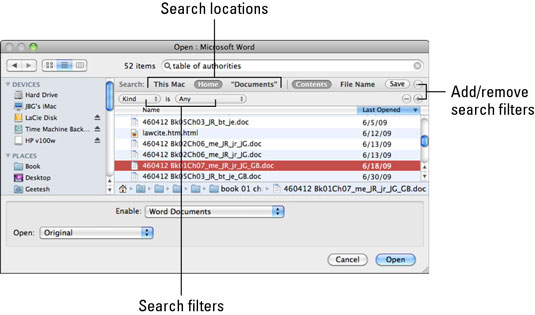
It is important to keep in mind that repeated spaces, tabs, and empty paragraphs are recognized as blanks by the screen reader. Most users are accustomed to indenting at the beginning of a paragraph using the ‘tab’ key, while others create this indentation by pressing the spacebar repeatedly until they are satisfied with the look of the indentation.
#On a mac search for specific word how to
Then select OK.Īdding Captions to Audio How to Add Captions to Audio In the Caption text box, please enter any text (with punctuation) that you would like to appear in the caption after the label.By selecting your preferred Format, your image will either say Figure 1 or Figure A. For example, instead of having a 1, 2, 3 Format, you can choose an A, B, C Format. By clicking on Numbering, you can choose the format of the numbering of your caption.Next to Position, please select whether you would like to have the caption appear above or below the image.Under Options, there will be choices provided to help name your image.Right click on the image or object to which you would like to add a caption.

Here are instructions on how to add a caption to a figure. For someone with a hearing disability, captions allow them to understand what the illustration is about without sound. By providing a title, a user can determine whether they would like to read the explanation.Īdding captions can be another helpful way to describe pictures for those who do not use a screenreader. You may enter a title for the image if you are providing the user with a long explanation. Under the Alt Text tab, enter an explanation of the picture or object in the Description box. On the left side of the Format Picture window, select Alt Text.Right click on the image or object to which you would like to add Alt Text.

You can add Alt Text to charts, pictures, shapes, and tables. You can either choose In line with text or Top and Bottom.Īdding Alt Text to Images & Objects What is Alt Text?Īlternative text (Alt Text) is text that you can add to describe images to be read by a screenreader.

To avoid this, you can use the Text-Wrapping feature to make sure the object is in line with text. Thus, the user will either miss it or will be unable to determine how this object fits into the content of the page. Because these objects are not in line with the text, the screenreader cannot determine that they are part of the content. The second example appears to have a structure through fonts, sizing, and bolding, but this manually created structure is not one a screenreader will recognize.įloating objects are any picture, illustration, and table within the document not in line with the text. Through this formatted structure, a screenreader will be able to recognize it and users can navigate through the document easily. In the first example, the headings were formatted through the Styles feature in Word. The difference in the two headings are not just the fonts, but the way they were created.


 0 kommentar(er)
0 kommentar(er)
